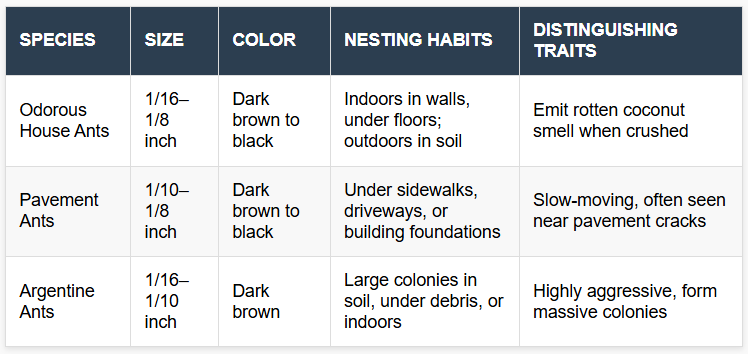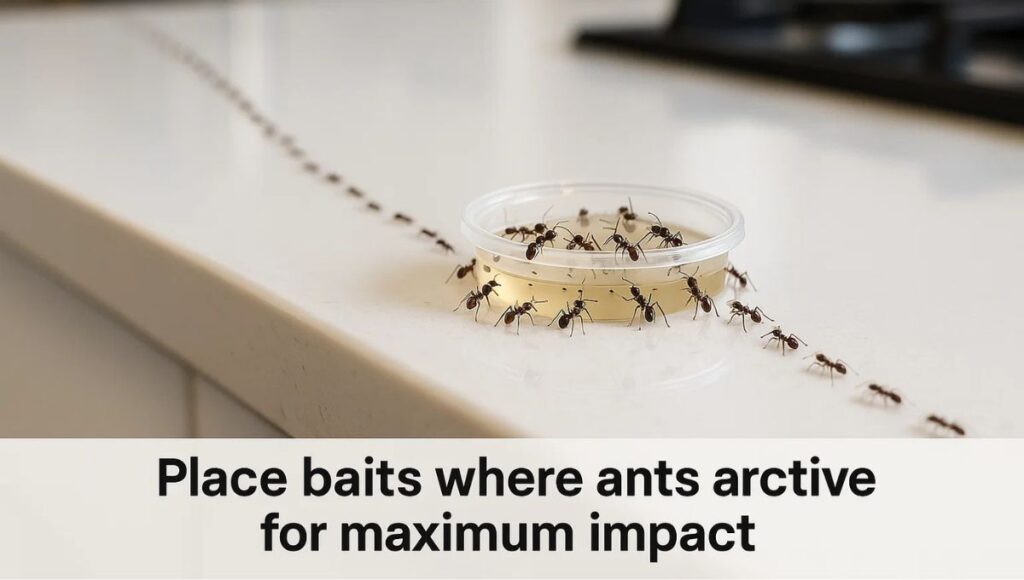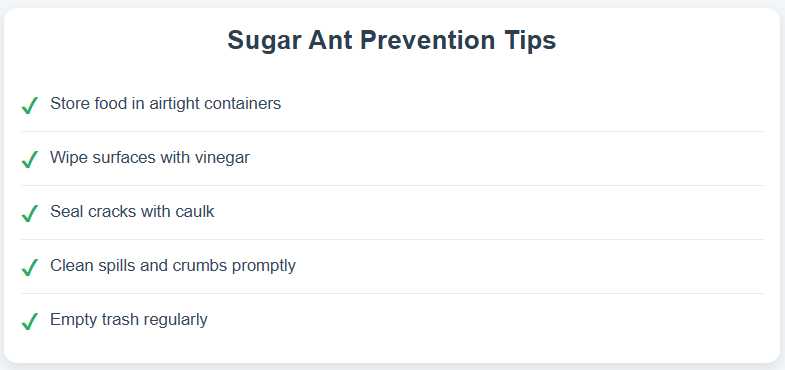How to Get Rid of Sugar Ants: Sugar ants invading your home can feel like an endless battle. These tiny pests sneak into kitchens, pantries, and even bathrooms, drawn by the promise of sweet crumbs and sticky spills. But don’t worry this guide will walk you through practical, effective steps to eliminate sugar ants and keep them out for good.
From identifying the culprits to sealing entry points and using baits, we’ve got you covered with expert tips tailored for homeowners. Let’s dive into how to get rid of sugar ants once and for all.
What Are Sugar Ants and Why Are They in Your Home?
Sugar ants, a common name for small ants like odorous house ants, pavement ants, or Argentine ants, are tiny (about 1/16 to 1/8 inch long) and range from black to dark brown. They’re nicknamed “sugar ants” because of their love for sweet foods, though they’ll also scavenge proteins and greasy leftovers. Understanding why they’re invading is the first step to kicking them out.
Common Causes of Sugar Ant Infestations
- Sweet Temptations: Spills of juice, honey, or syrup, or uncovered sugary snacks like cookies or fruit, act like a beacon for sugar ants.
- Moisture Havens: Leaky faucets, damp basements, or even pet water bowls provide the water these ants need to thrive.
- Easy Access Points: Cracks in walls, gaps around windows, or openings where pipes enter your home are highways for sugar ants.

Step-by-Step Guide to Eliminate Sugar Ants
Here’s a straightforward plan to reclaim your home from sugar ants. Follow these five steps for fast, lasting results.
Step 1: Identify the Ants
Not all ants are sugar ants, and misidentifying them can waste your time and effort. Sugar ants include species like:
- Odorous house ants: Dark brown, emit a rotten coconut smell when crushed.
- Pavement ants: Black or brown, often nest under sidewalks or driveways.
- Argentine ants: Dark brown, form large colonies, and are highly aggressive.
To confirm, observe their size, color, and behavior. Are they swarming around sweets? Follow their trail to locate entry points or nests. Accurate identification ensures you choose the right control methods.

Step 2: Seal Entry Points
Sugar ants are sneaky, squeezing through gaps as small as 1/16 inch. To stop them:
- Inspect your home: Check windows, doors, baseboards, and areas where pipes or wires enter. Look for visible ant trails, which often lead to entry points.
- Seal gaps: Use silicone caulk for cracks in walls or around windows. Weatherstrip doors and windows to close gaps.
- Fix screens: Repair torn window screens to block outdoor ants.
Sealing entry points not only stops new ants from entering but also traps existing ones, making baits more effective.
DIY Ant Control Methods: Safe and Effective Solutions for Your Home
Step 3: Remove Food Sources
Sugar ants are relentless foragers. A single crumb can keep them coming back. Here’s how to cut off their supply:
- Clean thoroughly: Wipe countertops, sweep floors, and vacuum carpets to remove crumbs and spills. Use a 1:1 mix of water and white vinegar to erase ant scent trails.
- Store food securely: Keep sweets, fruits, and pet food in airtight containers like glass jars or plastic bins with tight lids.
- Manage trash: Empty bins regularly and use trash cans with secure lids to avoid tempting ants.
A spotless kitchen is your first line of defense against sugar ants.
Step 4: Use Ant Baits
Baits are the most effective way to wipe out an entire sugar ant colony, including the queen. Here’s how to use them:
- Choose the right bait: Opt for sugar-based liquid or gel baits containing borax or boric acid, like Terro Liquid Ant Baits. These attract sugar ants and are carried back to the nest.
- Place strategically: Set baits near ant trails, entry points, or areas with heavy ant activity. Avoid placing them where pets or kids can reach.
- Be patient: It may take 3–7 days for the bait to kill the colony. Resist the urge to kill ants on sight, as they need to carry the bait back to the nest.

Step 5: Apply Deterrent Sprays
For an extra layer of protection, use sprays to repel ants and disrupt their trails:
- DIY option: Mix equal parts water and white vinegar in a spray bottle. Apply to countertops, baseboards, and entry points. The vinegar erases pheromone trails and repels ants.
- Commercial sprays: Choose pet-safe, non-toxic sprays labeled for indoor use. Avoid spraying near baits, as this can deter ants from taking the bait.
- Natural alternatives: Sprinkle diatomaceous earth (food-grade) or ground cinnamon along entry points. These are safe and deter ants without harmful chemicals.
If the infestation persists despite these steps, consider contacting a professional pest control service for advanced treatment.
Preventing Sugar Ants: Long-Term Strategies
Getting rid of sugar ants is only half the battle. To keep them out for good, adopt these prevention habits.
Secure Food Sources
- Airtight storage: Use containers like Tupperware or mason jars for pantry items. This blocks ants from detecting and accessing food.
- Prompt cleanup: Wash dishes immediately, clean spills, and avoid leaving food out overnight. A clean kitchen is less inviting to ants.
Maintain a Clean Home
- Regular cleaning: Wipe surfaces with vinegar weekly to disrupt ant trails. Vacuum floors and empty trash cans frequently.
- Pet food management: Feed pets at set times and remove uneaten food. Clean pet bowls daily to avoid attracting ants.
Block Entry Points
- Routine inspections: Check for new cracks or gaps after heavy rain or temperature changes, as these can create new entry points.
- Outdoor maintenance: Trim bushes and trees away from your home to reduce ant highways. Clear debris near your foundation where ants may nest.

When to Call a Professional
While DIY methods work for most sugar ant problems, large or recurring infestations may require expert help. Signs you need a pro:
- Ants return despite baits and sealing efforts.
- You find multiple nests or large colonies.
- Ants appear in unusual areas, like bedrooms or bathrooms, indicating hidden nests.
Professional pest control services can use stronger treatments and locate hard-to-find nests for complete eradication.
How to Get Rid of Ants Naturally: Safe and Effective Home Remedies
Conclusion
Sugar ants may be small, but they’re persistent. By identifying the species, sealing entry points, removing food sources, using baits, and applying deterrents, you can eliminate them effectively. Prevention is just as crucial keep your home clean, secure food, and stay vigilant for new entry points. With these steps, your home will stay ant-free, giving you peace of mind.
Follow this guide to take control and say goodbye to sugar ants for good. Have a tip or question about ant control? Share it with us in the comments!
FAQs; How to Get Rid of Sugar Ants
1. What are sugar ants?
Answer: Tiny black or brown ants, like odorous house ants or pavement ants, that love sugary foods.
2. Why do sugar ants invade my home?
Answer: They’re drawn to sugary spills, uncovered food, moisture, and tiny cracks for entry.
3. How can I identify sugar ants?
Answer: Look for small, dark ants trailing to sweets. Some, like odorous house ants, smell rotten when crushed.
4. What’s the best way to get rid of sugar ants?
Answer: Use sugar-based ant baits, seal entry points, and keep your kitchen clean.
5. Are natural remedies effective for sugar ants?
Answer: Yes, vinegar spray, diatomaceous earth, or cinnamon can repel ants and disrupt trails.
6. How do ant baits work?
Answer: Ants carry poison from baits back to their nest, killing the colony in 3–7 days.
7. How can I prevent sugar ants from returning?
Answer: Store food in airtight containers, clean with vinegar, and seal cracks.
8. Are sugar ants harmful?
Answer: They don’t damage homes but can contaminate food and spread bacteria.
9. Is it safe to use ant baits around pets?
Answer: Yes, if placed out of reach. Use pet-safe sprays or natural options like vinegar.
10. When should I call a professional?
Answer: If ants persist after two weeks, or you find large nests, contact pest control.






1 thought on “How to Get Rid of Sugar Ants: A Comprehensive DIY Guide”